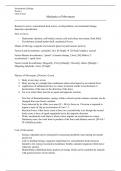Class notes
Mechanics of Movement in Invertebrates
- Course
- Institution
Modes of Moving, Physics, Cost, Passive Transport, Forces affecting Movement, Invertbrate mechanical movement, Muscular Locomotion, Muscular activity, Burrowing, Pseudo-Walking, Exoskeletons, Walking, Swimming, Flying, Jumping
[Show more]



